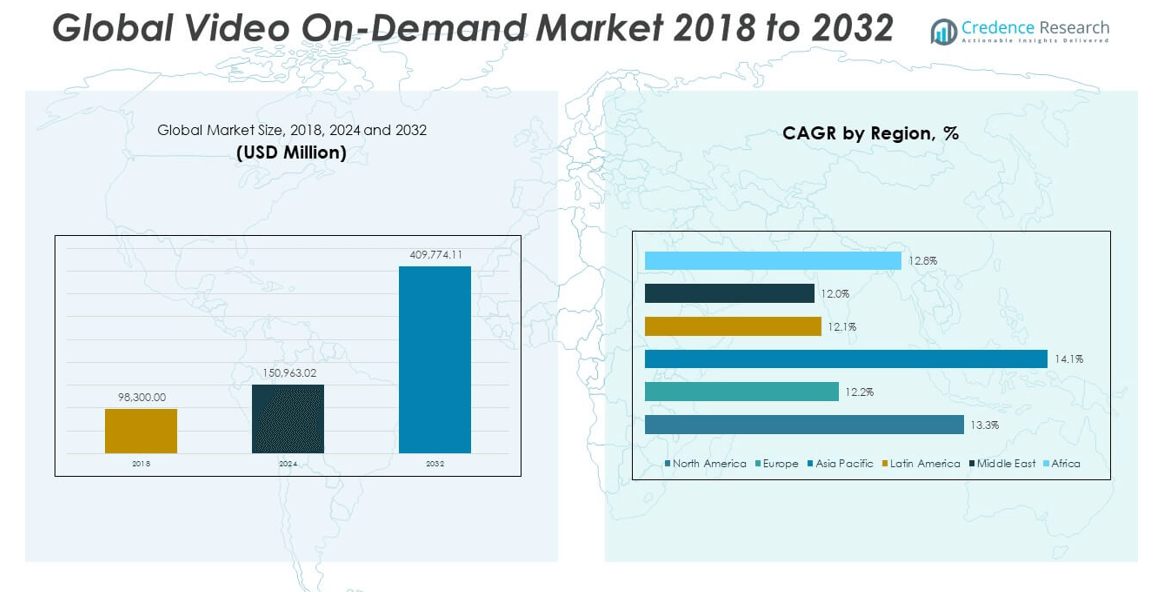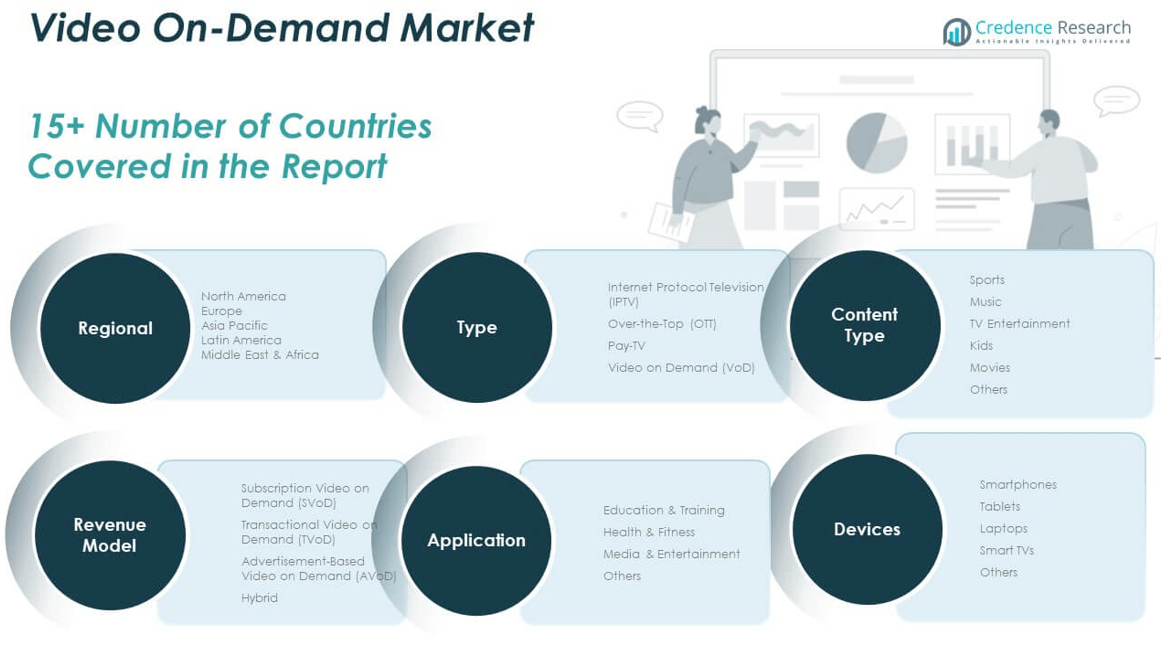CHAPTER NO. 1 : GENESIS OF THE MARKET
1.1 Market Prelude – Introduction & Scope
1.2 The Big Picture – Objectives & Vision
1.3 Strategic Edge – Unique Value Proposition
1.4 Stakeholder Compass – Key Beneficiaries
CHAPTER NO. 2 : EXECUTIVE LENS
2.1 Pulse of the Industry – Market Snapshot
2.2 Growth Arc – Revenue Projections (USD Million)
2.3. Premium Insights – Based on Primary Interviews
CHAPTER NO. 3 : VIDEO ON-DEMAND MARKET FORCES & INDUSTRY PULSE
3.1 Foundations of Change – Market Overview
3.2 Catalysts of Expansion – Key Market Drivers
3.2.1 Momentum Boosters – Growth Triggers
3.2.2 Innovation Fuel – Disruptive Technologies
3.3 Headwinds & Crosswinds – Market Restraints
3.3.1 Regulatory Tides – Compliance Challenges
3.3.2 Economic Frictions – Inflationary Pressures
3.4 Untapped Horizons – Growth Potential & Opportunities
3.5 Strategic Navigation – Industry Frameworks
3.5.1 Market Equilibrium – Porter’s Five Forces
3.5.2 Ecosystem Dynamics – Value Chain Analysis
3.5.3 Macro Forces – PESTEL Breakdown
3.6 Price Trend Analysis
3.6.1 Regional Price Trend
3.6.2 Price Trend by product
CHAPTER NO. 4 : KEY INVESTMENT EPICENTER
4.1 Regional Goldmines – High-Growth Geographies
4.2 Product Frontiers – Lucrative Product Categories
4.3 Application Sweet Spots – Emerging Demand Segments
CHAPTER NO. 5: REVENUE TRAJECTORY & WEALTH MAPPING
5.1 Momentum Metrics – Forecast & Growth Curves
5.2 Regional Revenue Footprint – Market Share Insights
5.3 Segmental Wealth Flow – Type & Application Revenue
CHAPTER NO. 6 : TRADE & COMMERCE ANALYSIS
6.1. Import Analysis by Region
6.1.1. Global Video On-Demand Market Import Revenue By Region
6.2. Export Analysis by Region
6.2.1. Global Video On-Demand Market Export Revenue By Region
CHAPTER NO. 7 : COMPETITION ANALYSIS
7.1. Company Market Share Analysis
7.1.1. Global Video On-Demand Market: Company Market Share
7.2. Global Video On-Demand Market Company Revenue Market Share
7.3. Strategic Developments
7.3.1. Acquisitions & Mergers
7.3.2. New Product Launch
7.3.3. Regional Expansion
7.4. Competitive Dashboard
7.5. Company Assessment Metrics, 2024
CHAPTER NO. 8 : VIDEO ON-DEMAND MARKET – BY TYPE SEGMENT ANALYSIS
8.1. Video On-Demand Market Overview by Type Segment
8.1.1. Video On-Demand Market Revenue Share By Type
8.2. Internet Protocol Television (IPTV)
8.3. Over-the-Top (OTT)
8.4. Pay-TV
8.5. Video on Demand (VoD)
CHAPTER NO. 9 : VIDEO ON-DEMAND MARKET – BY APPLICATION SEGMENT ANALYSIS
9.1. Video On-Demand Market Overview by Application Segment
9.1.1. Video On-Demand Market Revenue Share By Application
9.2. Education & Training
9.3. Health & Fitness
9.4. Media & Entertainment
9.5. Others
CHAPTER NO. 10 : VIDEO ON-DEMAND MARKET – BY CONTENT TYPE SEGMENT ANALYSIS
10.1. Video On-Demand Market Overview by Content Type Segment
10.1.1. Video On-Demand Market Revenue Share By Content Type
10.2. Sports
10.3. Music
10.4. TV Entertainment
10.5. Kids
10.6. Movies
10.7. Others
CHAPTER NO. 11 : VIDEO ON-DEMAND MARKET – BY DEVICE SEGMENT ANALYSIS
11.1. Video On-Demand Market Overview by Device Segment
11.1.1. Video On-Demand Market Revenue Share By Device
11.2. Smartphones
11.3. Tablets
11.4. Laptops
11.5. Smart TVs
11.6. Others
CHAPTER NO. 12 : VIDEO ON-DEMAND MARKET – BY REVENUE MODEL SEGMENT ANALYSIS
12.1. Video On-Demand Market Overview by Revenue Model Segment
12.1.1. Video On-Demand Market Revenue Share By Revenue Model
12.2. Subscription Video on Demand (SVoD)
12.3. Transactional Video on Demand (TVoD)
12.4. Advertisement-Based Video on Demand (AVoD)
12.5. Hybrid
CHAPTER NO. 13 : VIDEO ON-DEMAND MARKET – REGIONAL ANALYSIS
13.1. Video On-Demand Market Overview by Region Segment
13.1.1. Global Video On-Demand Market Revenue Share By Region
13.1.2. Regions
13.1.3. Global Video On-Demand Market Revenue By Region
13.1.4. Type
13.1.5. Global Video On-Demand Market Revenue By Type
13.1.6. Application
13.1.7. Global Video On-Demand Market Revenue By Application
13.1.8. Content Type
13.1.9. Global Video On-Demand Market Revenue By Content Type
13.1.10. Device
13.1.12. Global Video On-Demand Market Revenue By Device
13.1.13. Revenue Model
13.1.14. Global Video On-Demand Market Revenue By Revenue Model
CHAPTER NO. 14 : NORTH AMERICA VIDEO ON-DEMAND MARKET – COUNTRY ANALYSIS
14.1. North America Video On-Demand Market Overview by Country Segment
14.1.1. North America Video On-Demand Market Revenue Share By Region
14.2. North America
14.2.1. North America Video On-Demand Market Revenue By Country
14.2.2. Type
14.2.3. North America Video On-Demand Market Revenue By Type
14.2.4. Application
14.2.5. North America Video On-Demand Market Revenue By Application
14.2.6. Content Type
14.2.7. North America Video On-Demand Market Revenue By Content Type
14.2.8. Device
14.2.9. North America Video On-Demand Market Revenue By Device
14.2.10. Revenue Model
14.2.11. North America Video On-Demand Market Revenue By Revenue Model
14.3. U.S.
14.4. Canada
14.5. Mexico
CHAPTER NO. 15 : EUROPE VIDEO ON-DEMAND MARKET – COUNTRY ANALYSIS
15.1. Europe Video On-Demand Market Overview by Country Segment
15.1.1. Europe Video On-Demand Market Revenue Share By Region
15.2. Europe
15.2.1. Europe Video On-Demand Market Revenue By Country
15.2.2. Type
15.2.3. Europe Video On-Demand Market Revenue By Type
15.2.4. Application
15.2.5. Europe Video On-Demand Market Revenue By Application
15.2.6. Content Type
15.2.7. Europe Video On-Demand Market Revenue By Content Type
15.2.8. Device
15.2.9. Europe Video On-Demand Market Revenue By Device
15.2.10. Revenue Model
15.2.11. Europe Video On-Demand Market Revenue By Revenue Model
15.3. UK
15.4. France
15.5. Germany
15.6. Italy
15.7. Spain
15.8. Russia
15.9. Rest of Europe
CHAPTER NO. 16 : ASIA PACIFIC VIDEO ON-DEMAND MARKET – COUNTRY ANALYSIS
16.1. Asia Pacific Video On-Demand Market Overview by Country Segment
16.1.1. Asia Pacific Video On-Demand Market Revenue Share By Region
16.2. Asia Pacific
16.2.1. Asia Pacific Video On-Demand Market Revenue By Country
16.2.2. Type
16.2.3. Asia Pacific Video On-Demand Market Revenue By Type
16.2.4. Application
16.2.5. Asia Pacific Video On-Demand Market Revenue By Application
16.2.6. Content Type
16.2.7. Asia Pacific Video On-Demand Market Revenue By Content Type
16.2.8. Device
16.2.9. Asia Pacific Video On-Demand Market Revenue By Device
16.2.10. Revenue Model
16.2.11. Asia Pacific Video On-Demand Market Revenue By Revenue Model
16.3. China
16.4. Japan
16.5. South Korea
16.6. India
16.7. Australia
16.8. Southeast Asia
16.9. Rest of Asia Pacific
CHAPTER NO. 17 : LATIN AMERICA VIDEO ON-DEMAND MARKET – COUNTRY ANALYSIS
17.1. Latin America Video On-Demand Market Overview by Country Segment
17.1.1. Latin America Video On-Demand Market Revenue Share By Region
17.2. Latin America
17.2.1. Latin America Video On-Demand Market Revenue By Country
17.2.2. Type
17.2.3. Latin America Video On-Demand Market Revenue By Type
17.2.4. Application
17.2.5. Latin America Video On-Demand Market Revenue By Application
17.2.6. Content Type
17.2.7. Latin America Video On-Demand Market Revenue By Content Type
17.2.8. Device
17.2.9. Latin America Video On-Demand Market Revenue By Device
17.2.10. Revenue Model
17.2.11. Latin America Video On-Demand Market Revenue By Revenue Model
17.3. Brazil
17.4. Argentina
17.5. Rest of Latin America
CHAPTER NO. 18 : MIDDLE EAST VIDEO ON-DEMAND MARKET – COUNTRY ANALYSIS
18.1. Middle East Video On-Demand Market Overview by Country Segment
18.1.1. Middle East Video On-Demand Market Revenue Share By Region
18.2. Middle East
18.2.1. Middle East Video On-Demand Market Revenue By Country
18.2.2. Type
18.2.3. Middle East Video On-Demand Market Revenue By Type
18.2.4. Application
18.2.5. Middle East Video On-Demand Market Revenue By Application
18.2.6. Content Type
18.2.7. Middle East Video On-Demand Market Revenue By Content Type
18.2.8. Device
18.2.9. Middle East Video On-Demand Market Revenue By Device
18.2.10. Revenue Model
18.2.11. Middle East Video On-Demand Market Revenue By Revenue Model
18.3. GCC Countries
18.4. Israel
18.5. Turkey
18.6. Rest of Middle East
CHAPTER NO. 19 : AFRICA VIDEO ON-DEMAND MARKET – COUNTRY ANALYSIS
19.1. Africa Video On-Demand Market Overview by Country Segment
19.1.1. Africa Video On-Demand Market Revenue Share By Region
19.2. Africa
19.2.1. Africa Video On-Demand Market Revenue By Country
19.2.2. Type
19.2.3. Africa Video On-Demand Market Revenue By Type
19.2.4. Application
19.2.5. Africa Video On-Demand Market Revenue By Application
19.2.6. Content Type
19.2.7. Africa Video On-Demand Market Revenue By Content Type
19.2.8. Device
19.2.9. Africa Video On-Demand Market Revenue By Device
19.2.10. Revenue Model
19.2.11. Africa Video On-Demand Market Revenue By Revenue Model
19.3. South Africa
19.4. Egypt
19.5. Rest of Africa
CHAPTER NO. 20 : COMPANY PROFILES
20.1. Netflix, Inc.
20.1.1. Company Overview
20.1.2. Product Portfolio
20.1.3. Financial Overview
20.1.4. Recent Developments
20.1.5. Growth Strategy
20.1.6. SWOT Analysis
20.2. Amazon.com, Inc. (USA)
20.3. Hulu LLC (USA)
20.4. Apple, Inc. (USA)
20.5. Google LLC (USA)
20.6. Comcast Corporation (USA)
20.7. Facebook, Inc. (USA)
20.8. AT&T, Inc. (USA)
20.9. The Walt Disney Company (USA)
20.10. Verizon Communications Inc. (USA)
20.11. Sony Corporation (Japan)
20.12. Rakuten, Inc. (Japan)
20.13. Tencent Holdings Ltd. (China)
20.14. iQIYI, Inc. (China)
20.15. Alibaba Group Holding Limited (China)
20.16. Telefonaktiebolaget LM Ericsson (Sweden)
20.17. Deutsche Telekom AG (Germany)
20.18. Vivendi SE (France)
20.19. Sky Group (UK)
20.20. BBC iPlayer (UK)









